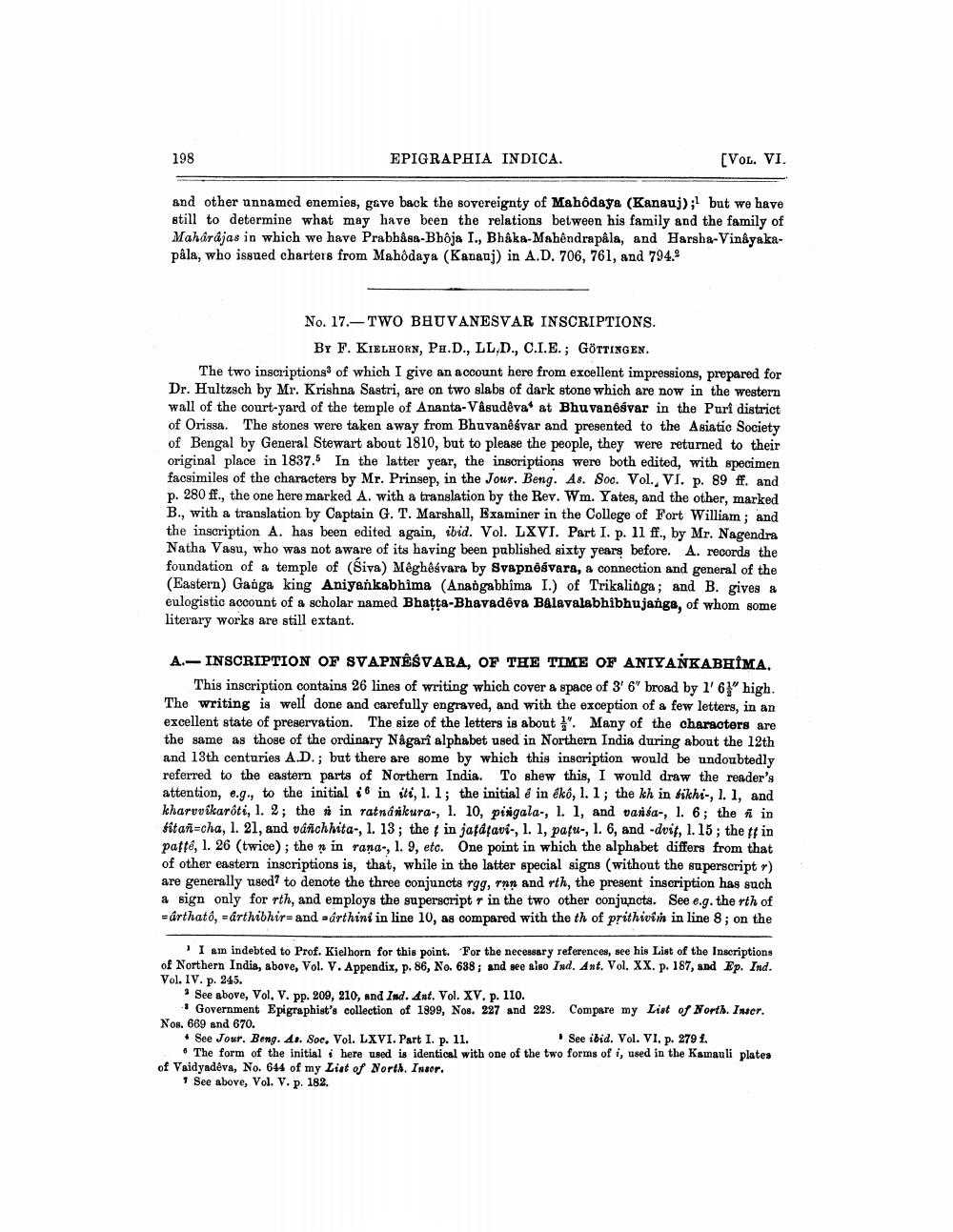________________
198
EPIGRAPHIA INDICA.
[VOL. VI.
and other unnamed enemies, gave back the sovereignty of Mahôdaya (Kanauj);1 but we have still to determine what may have been the relations between his family and the family of Maharajas in which we have Prabhâsa-Bhôja I., Bhâka-Mahendrapâla, and Harsha-Vinayakapâla, who issued charters from Mahôdaya (Kanauj) in A.D. 706, 761, and 794.2
No. 17. TWO BHUVANESVAR INSCRIPTIONS.
BY F. KIELHORN, PH.D., LL,D., C.I.E.; GÖTTINGEN.
The two inscriptions of which I give an account here from excellent impressions, prepared for Dr. Hultzsch by Mr. Krishna Sastri, are on two slabs of dark stone which are now in the western wall of the court-yard of the temple of Ananta-Vasudeva' at Bhuvanesvar in the Purî district of Orissa. The stones were taken away from Bhuvanêévar and presented to the Asiatic Society of Bengal by General Stewart about 1810, but to please the people, they were returned to their original place in 1837.5 In the latter year, the inscriptions were both edited, with specimen facsimiles of the characters by Mr. Prinsep, in the Jour. Beng. As. Soc. Vol., VI. p. 89 ff. and p. 280 ff., the one here marked A. with a translation by the Rev. Wm. Yates, and the other, marked B., with a translation by Captain G. T. Marshall, Examiner in the College of Fort William; and the inscription A. has been edited again, ibid. Vol. LXVI. Part I. p. 11 ff., by Mr. Nagendra Natha Vasu, who was not aware of its having been published sixty years before. A. records the foundation of a temple of (Siva) Mêghêévara by Svapnêsvara, a connection and general of the (Eastern) Ganga king Aniyankabhima (Anangabhima I.) of Trikalinga; and B. gives a eulogistic account of a scholar named Bhaṭṭa-Bhavadeva Bâlavalabhibhujanga, of whom some literary works are still extant.
A.- INSCRIPTION OF SVAPNESVARA, OF THE TIME OF ANIYANKABHIMA,
This inscription contains 26 lines of writing which cover a space of 3' 6" broad by 1' 6" high. The writing is well done and carefully engraved, and with the exception of a few letters, in an excellent state of preservation. The size of the letters is about". Many of the characters are the same as those of the ordinary Nâgarî alphabet used in Northern India during about the 12th and 13th centuries A.D.; but there are some by which this inscription would be undoubtedly referred to the eastern parts of Northern India. To shew this, I would draw the reader's attention, e.g., to the initial 6 in iti, 1. 1; the initial é in ékô, 1. 1; the kh in sikhi-, 1. 1, and kharvvikarôti, 1. 2; then in ratnánkura-, 1. 10, pisgala-, 1. 1, and vansa-, 1. 6; the in sitañ-cha, 1. 21, and váñchhita-, 1. 13; the t in jatâtavi-, 1. 1, patu-, 1. 6, and -dvit, 1. 15; the tt in patte, 1. 26 (twice); the n in rana-, 1. 9, etc. One point in which the alphabet differs from that of other eastern inscriptions is, that, while in the latter special signs (without the superscript r) are generally used? to denote the three conjuncts rgg, ran and rth, the present inscription has such a sign only for rth, and employs the superscript r in the two other conjuncts. See e.g. the rth of =ârtható, =ârthibhir= and arthini in line 10, as compared with the th of prithivim in line 8; on the
I am indebted to Prof. Kielhorn for this point. For the necessary references, see his List of the Inscriptions of Northern India, above, Vol. V. Appendix, p. 86, No. 638; and see also Ind. Ant. Vol. XX. p. 187, and Ep. Ind. Vol. IV. p. 245.
See above, Vol. V. pp. 209, 210, and Ind. Ant. Vol. XV. p. 110.
Government Epigraphist's collection of 1899, Nos. 227 and 229. Compare my List of North. Inser. Nos. 669 and 670.
See Jour. Beng. As. Soc. Vol. LXVI. Part I. p. 11.
See ibid. Vol. VI. p. 279 1.
The form of the initial here used is identical with one of the two forms of i, used in the Kamauli plates of Vaidyadeva, No. 644 of my List of North. Insor.
1 See above, Vol. V. p. 182.




